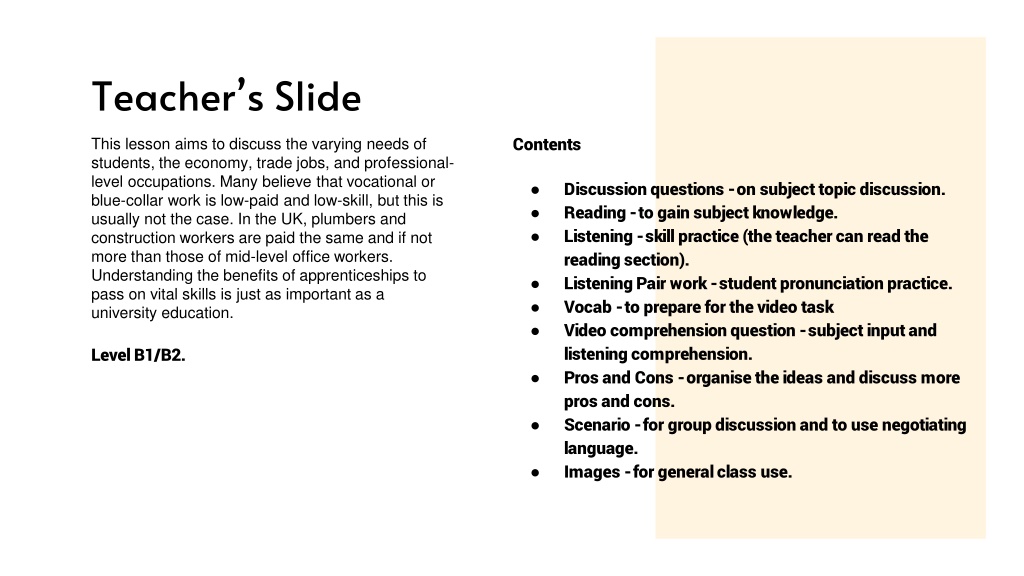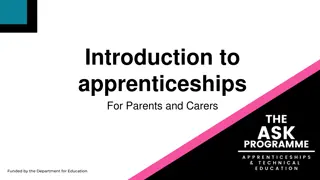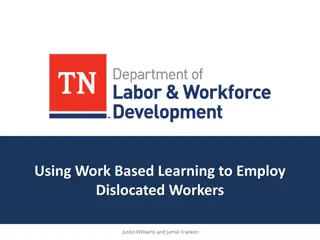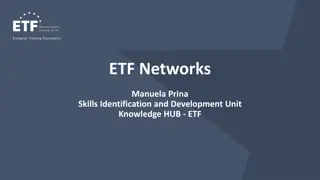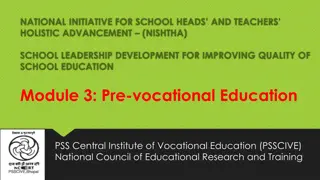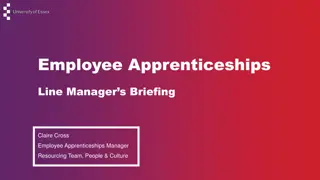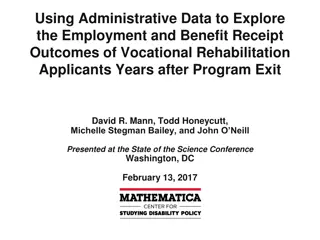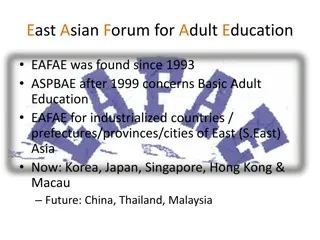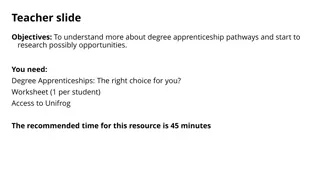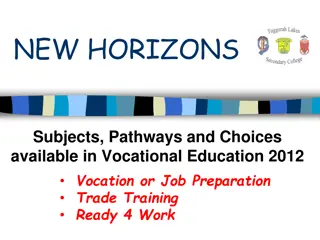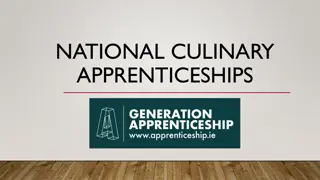Exploring Benefits of Apprenticeships and Vocational Education
This lesson delves into the varying needs of students in relation to the economy, trade jobs, and professional-level occupations, highlighting that vocational work is often well-paid and skill-intensive. It emphasizes the importance of apprenticeships in passing on crucial skills and challenges the notion that blue-collar jobs are inferior. Discussion questions, readings, listening exercises, and group activities provide a comprehensive learning experience for students at B1/B2 level.
Download Presentation

Please find below an Image/Link to download the presentation.
The content on the website is provided AS IS for your information and personal use only. It may not be sold, licensed, or shared on other websites without obtaining consent from the author. Download presentation by click this link. If you encounter any issues during the download, it is possible that the publisher has removed the file from their server.
E N D
Presentation Transcript
Teachers Slide Contents This lesson aims to discuss the varying needs of students, the economy, trade jobs, and professional- level occupations. Many believe that vocational or blue-collar work is low-paid and low-skill, but this is usually not the case. In the UK, plumbers and construction workers are paid the same and if not more than those of mid-level office workers. Understanding the benefits of apprenticeships to pass on vital skills is just as important as a university education. Discussion questions -on subject topic discussion. Reading -to gain subject knowledge. Listening -skill practice (the teacher can read the reading section). Listening Pair work -student pronunciation practice. Vocab -to prepare for the video task Video comprehension question -subject input and listening comprehension. Pros and Cons -organise the ideas and discuss more pros and cons. Scenario -for group discussion and to use negotiating language. Images -for general class use. Level B1/B2.
These factory workers get paid to go to school Work and training
Quotations. Read each quote and discuss if you agree with their opinion or not. Explain why you do or don t. Which quote do you agree with the most? Apprenticeship is a proven model for developing a skilled workforce. My professional apprenticeship at Iowa State College from 1930 to 1943 could not have been better; the Great Depression made it so, and the talented younger economists at Ames during that period made it an exciting and profitable intellectual experience. -Eugene Scalia -Theodore Schultz I graduated from university with a degree in architecture and then ended up doing a series of internships with different firms. And once I was in an office environment, I realized that at school what I was doing was 98 percent creative, 2 percent makework, but in the real world, it was the other way around. You can't have a university without having free speech, even though at times it makes us terribly uncomfortable. If students are not going to hear controversial ideas on college campuses, they're not going to hear them in America. I believe it's part of their education. -Daniel Wu -Donna Shalala
Discussion Questions 1/2 1. When was the last time you looked for a job? What was the experience like? 2. How can you prepare yourself for a job interview? 3. What kind of questions do employers ask? 4. Have you heard of apprenticeships? Have you considered doing one? 5. What are the benefits and drawbacks of apprenticeships?
Discussion Questions 2/2 1. The U.S. Department of Labour has recognised over 1000 job types where an apprenticeship role can be created. More are added from year to year. What specific occupations can you learn on the job and which must be taught in universities? 2. According to figures from the UK Commission for Employment and Skills, 92% of employers believe that apprentices lead to a more motivated and satisfied workforce. So, to what extent do apprenticeships benefit businesses, if at all? What disadvantages could there be for employees 3. If a person feels too old for an apprenticeship and under-qualified for an internship, is there any other alternative available in your country? What about in other countries? 4. Apprenticeships are valuable for direct job-related skills. In your opinion what is more important in the workplace: qualifications or experience?
Reading 1/3 These factory workers get paid to go to school Jobs are often grouped into "blue collar" and "white collar" as it was the traditional colour of shirt while in different working environments. What set them apart was that blue-collar workers performed manual labour, like plumbing and construction, while white-collar workers were from the professional job class, like lawyers and doctors. These occupational categories do not seem so important, but the economy was and can be divided by these two types of job. Traditionally, blue-collar workers wore uniforms, typically blue, and worked in trade occupations. Instead, white-collar workers normally wore white shirts and worked in office settings. Wages and education level are among the other aspects that separate blue-collar and white-collar workers. In this way, blue- collar workers are often associated with vocational education and skills related to their hands. This stereotype is quite wrong.
Reading 2/3 These factory workers get paid to go to school Most blue-collar occupations involve specialised skills, extensive training, and technical expertise. For something as common as bricklaying, there are many years of practice required, as well as exams to pass to ensure quality is high. It is important to note that apprenticeships are common in blue-collar occupations. This is where training on the job, or learning and earning is the main component of learning the skill. Apprenticeships are a valuable way to learn vital skills in several critical trades. The Chinese have a long history of apprenticeships. Long ago, Confucius once said, If you memorise knowledge only, no matter how much you learn, what practical use is it if you cannot adequately perform tasks? .
Reading 3/3 These factory workers get paid to go to school In the UK, the BBC, for instance, has numerous apprenticeship schemes focusing on journalism, business support, production, and technology. Though it is very popular to attend university to study a subject, It is possible to have a career in an industry without going to university, saving money along the way. That said, university enrolment in the UK is still very popular. In 2017, President Trump signed an executive order to increase the number of US apprenticeships to 5 million by the year 2022. This trend is to address the need for important workers in the economy, but also provide an alternative to university, which may not be the best route for every young person making their way into the job market.
Reading Questions 1. 2. 3. 4. 5. 6. 7. 8. 9. 10. Work, especially physical work. 11. Whose job requires manual labour. A thorough examination of machinery or a system, with repairs or changes made if necessary. A group of people who are either in work or are able to work. A manufacturing process in which individual parts of a larger product are put together in a specific order. A training programme for junior employees. Relocate (a business or department) to a foreign country to take advantage of lower costs. Involving the agreement or cooperation of two political parties that usually oppose each other's policies. Fill (accommodations or space) beyond what is usual or comfortable. The use of largely automatic equipment in a system of manufacturing or another production process. No longer produced or used; out of date.
Listening Gap Fill For listening or vocabulary task
Listening Gap Fill 1/3 These factory workers get paid to go to school Jobs are often [1] __________ into "blue-collar" and "white collar" as it was the [2] __________ colour of shirt while in different working [3] __________ . What [4] __________ them apart was that blue-collar workers [5] __________ manual labour, like [6] __________ and [7] __________ , while white-collar workers were from the [8] __________ job class, like [9] __________ and [10] __________ . These occupational categories do not seem so [11] __________ , but the [12] __________ was and can be [13] __________ by these two types of job. Traditionally, blue-collar workers [14] __________ uniforms, typically blue, and worked in [15] __________ occupations. [16] __________ , white-collar workers [17] __________ wore white shirts and worked in office [18] __________ . Wages and education level are [19] __________ the other aspects that [20] __________ blue-collar and white-collar workers.
Listening Gap Fill 2/3 These factory workers get paid to go to school In this way, blue-collar workers are often [21] __________ with vocational education and skills [22] __________ to their hands. This [23] __________ is quite wrong. Most blue-collar occupations involve specialised skills, [24] __________ training, and technical expertise. For something as common as [25] __________ , there are many years of practice [26] __________ , as well as exams to pass to ensure [27] __________ is high. It is important to note that apprenticeships are [28] __________ in blue-collar occupations. This is [29] __________ training on the job, or learning and earning is the main [30] __________ of learning the skill. Apprenticeships are a [31] __________ way to learn vital skills in several critical trades.
Listening Gap Fill 3/3 These factory workers get paid to go to school The [32] __________ have a long history of apprenticeships. Long ago, Confucius once said, If you [33] __________ knowledge only, no matter how much you learn, what practical use is it if you cannot [34] __________ perform tasks? . In the UK, the BBC, for instance, has numerous apprenticeship [35] __________ focusing on [36] __________ , business support, production, and [37] __________ . Though it is very popular to attend university to study a subject, It is possible to have a career in an industry [38] __________ going to university, [39] __________ money along the way. That said, university enrolment in the UK is still very [40] __________ . In 2017, President Trump signed an [41] __________ order to increase the number of US apprenticeships to 5 million by the year 2022. This [42] __________ is to address the need for important workers in the economy, but also provide an [43] __________ to university, which may not be the best [44] __________ for every young person making their way into the job [45] __________ .
Vocab Matching For listening or vocabulary task
Vocab Matching 1. 2. 3. 4. 5. 6. 7. 8. 9. 10. Work, especially physical work. 11. Whose job requires manual labour. A thorough examination of machinery or a system, with repairs or changes made if necessary. A group of people who are either in work or are able to work. A manufacturing process in which individual parts of a larger product are put together in a specific order. A training programme for junior employees. Relocate (a business or department) to a foreign country to take advantage of lower costs. Involving the agreement or cooperation of two political parties that usually oppose each other's policies. Fill (accommodations or space) beyond what is usual or comfortable. The use of largely automatic equipment in a system of manufacturing or another production process. No longer produced or used; out of date. A. Labour B. Overcrowded C. Assembly line D. Workforce E. Overhaul F. Automation G. Offshoring H. Bipartisan I. Apprenticeship J. Obsolete K. Blue-collar
Vocab Matching ANSWERS 1. 2. 3. 4. 5. 6. 7. 8. 9. 10. Work, especially physical work. 11. Whose job requires manual labour. A thorough examination of machinery or a system, with repairs or changes made if necessary. A group of people who are either in work or are able to work. A manufacturing process in which individual parts of a larger product are put together in a specific order. A training programme for junior employees. Relocate (a business or department) to a foreign country to take advantage of lower costs. Involving the agreement or cooperation of two political parties that usually oppose each other's policies. Fill (accommodations or space) beyond what is usual or comfortable. The use of largely automatic equipment in a system of manufacturing or another production process. No longer produced or used; out of date. OBSOLETE LABOUR OVERHAUL A. Labour B. Overcrowded C. Assembly line D. Workforce E. Overhaul F. Automation G. Offshoring H. Bipartisan I. Apprenticeship J. Obsolete K. Blue-collar WORKFORCE ASSEMBLY LINE APPRENTICESHIP OFFSHORING BIPARTISAN OVERCROWDED AUTOMATION BLUE-COLLAR
Video Comprehension 1. 2. 3. 4. What is the workforce in manufacturing facing nowadays? Has automation shrunk manufacturing jobs? How are blue-collar workers coping with automation now? How do apprenticeships differ from other training programmes? What are the benefits of apprenticeships? What seems to be the marketing problem in relation to apprenticeships in the United States? In what field is the vast majority of apprenticeships concentrated? What happens in countries like Germany and Australia? What is the manufacturing industry projecting? 10. Which are the abilities needed to fill the skills gap ? 5. 6. 7. Video Links: https://www.youtube.com/watch?v=BU1w- yxQw1k https://esldebates.com/these-factory- workers-get-paid-to-go-to-school/ 8. 9.
Video Comprehension ANSWERS ANSWERS 1. What is the workforce in manufacturing facing nowadays? It is facing a major overhaul. 2. Has automation shrunk manufacturing jobs? Yes, it has. But, although automation offshoring has shrunk manufacturing jobs drastically over the past few decades, the industry is actually adding jobs now. 3. How are blue-collar workers coping with automation now? Manufacturers are quick to adapt to automation, but workers need to adapt now. And the solution is bipartisan support: on the job apprenticeship. 4. How do apprenticeships differ from other training programmes? Apprenticeships have to offer combined classroom or conceptual learning with on-the-job mentored training. Apprentices must be paid and employed by the firm and they have to last at least a year ending with a degree, certification or both. 5. What are the benefits of apprenticeships? This means that apprentices earn on-the-job experience, while building an educational foundation simultaneously and they are earning money while they do it.
Video Comprehension ANSWERS ANSWERS 6. What seems to be the marketing problem in relation to apprenticeships in the United States? Americans often think of apprenticeship as old-timey training for blue-collar work. 7. In what field is the vast majority of apprenticeships concentrated? The vast majority of apprenticeships in the United States are concentrated in the construction field, and they rely heavily on contributions from Union labourers. 8. What happens in countries like Germany and Australia? In countries like Germany and Australia students can get an apprenticeship in nearly any profession, from IT to banking to hospitality and advanced manufacturing. Many of these students go on to complete a 4 year degree on top of the certifications. 9. What is the manufacturing industry projecting? The manufacturing industry is projecting three and a half million new job openings over the next decade. 10. Which are the abilities needed to fill the skills gap ? The skills needed are: higher proficiency in math skills (60%), tech and computer skills (70%) and basic technical training (67%).
Pros and Cons Read the opinions in the boxes on the next slides and organise them as either a pro or con for apprenticeships. Once you have completed, work in a group and try to think of other benefits and drawbacks.
Pros and Cons Minimal Recognition: Apprentices are usually less esteemed within a project or work team compared to full-time workers that respect each other as professionals. Work Limitations: Some apprentices are limited from engaging in some types of activities by legal or practical standards. States that require apprentices to hold a license or certification for certain types of electrical, plumbing or construction work may impede participation. Work Limitations: Some apprentices are limited from engaging in some types of activities by legal or practical standards. States that require apprentices to hold a license or certification for certain types of electrical, plumbing or construction work may impede participation. Low Pay: Apprentices typically receive significantly lower pay than certified or professional workers, despite often sharing the same basic projects and tasks. This is generally because an apprentice is less experienced and skilled than his or her mentor.
Pros and Cons Finances: The apprentices will be paid a salary from day one, rather than accumulating considerable student debt over the course of a degree. Experience: The apprentices will get hands-on training from the moment they begin. They will be ahead of university graduates who arrive a number of years later with a lot of academic knowledge but very little or no on-the-ground experience. Inequality: Some apprenticeships are less well supported and less well paid than others. In addition, similar to other interns and trainees, apprentices are often subject to "gofering" which is common slang for being given unpleasant tasks that the professional worker does not want to do. Confidence: On completing an apprenticeship, many apprentices have far more confidence than university graduates just starting out on account of wide-ranging practical experience of the industry they operate in.
Debate Motions
Debates This house believes that a four-year university degree is often the best route to a profession. This house believes that local government should pay for retraining and apprenticeships. This house believes that companies are too reluctant to train their own workforce.
